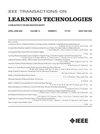面向在线工程教育的增强现实工具的开发与可用性测试
IF 2.9
3区 教育学
Q2 COMPUTER SCIENCE, INTERDISCIPLINARY APPLICATIONS
引用次数: 0
摘要
本文介绍了基于社会呈现的增强现实(SPEAR)工具的开发过程,这是一种为在线工程教育量身定制的基于增强现实(AR)的创新学习应用程序。SPEAR专注于结构光束弯曲的学习模块,使用户能够使用Unity游戏引擎中的AR基础框架将3d虚拟光束无缝集成到他们的现实环境中。学习者可以通过操纵载荷和位置来探索结构力学。SPEAR利用基于有限元方法的自定义c#脚本提供梁变形的实时模拟,并附带力矩/剪切图和弯曲应力的可视化。此外,集成了基于云的语音聊天功能,光子统一网络,增强了社交存在,促进了协作学习。与扩展现实开发人员和结构工程师一起进行的可用性测试,利用系统可用性量表,证实了SPEAR的用户友好性和直观的界面。结果表明高水平的参与者满意度,验证了其设计和功能。这项研究通过突出SPEAR的教学潜力,通过沉浸式AR体验和社交互动来增强在线工程教育,从而为该领域做出了贡献。它为提高学生的参与度、理解力和表现提供了一条有希望的途径。此外,SPEAR促进了未来对新的学习理论和材料设计策略的研究。它的多功能性使其成为创新在线教育方法的宝贵工具,有可能彻底改变全球学生的学习体验。本文章由计算机程序翻译,如有差异,请以英文原文为准。
Developing and Usability Testing of an Augmented Reality Tool for Online Engineering Education
This article introduces the development process of social presence-enabled augmented reality (SPEAR) tool, an innovative augmented reality (AR) based learning application tailored for online engineering education. SPEAR focuses on a learning module of structural beam-bending, empowering users to seamlessly integrate 3-D virtual beams into their real-world environment, using the AR Foundation framework within the Unity game engine. Learners can explore structural mechanics by manipulating loads and positions. SPEAR leverages a custom C# script based on the finite element method to offer a real-time simulation of beam deformation, accompanied by visualizations of the moment/shear diagrams and bending stresses. In addition, the integration of a cloud-based voice chat feature, photon unity networking 2, enhances social presence, fostering collaborative learning. Usability testing conducted with extended reality developers and structural engineers, utilizing the system usability scale, confirmed SPEAR's user-friendliness and intuitive interface. Results indicate high levels of participant satisfaction, validating its design and functionality. This study contributes to the field by highlighting SPEAR's pedagogical potential to enhance online engineering education through immersive AR experiences and social interaction. It offers a promising avenue for improving student engagement, comprehension, and performance. In addition, SPEAR facilitates future research into new learning theories and materials design strategies. Its versatility makes it a valuable tool for innovative online education approaches, potentially revolutionizing the learning experiences for students worldwide.
求助全文
通过发布文献求助,成功后即可免费获取论文全文。
去求助
来源期刊

IEEE Transactions on Learning Technologies
COMPUTER SCIENCE, INTERDISCIPLINARY APPLICATIONS-
CiteScore
7.50
自引率
5.40%
发文量
82
审稿时长
>12 weeks
期刊介绍:
The IEEE Transactions on Learning Technologies covers all advances in learning technologies and their applications, including but not limited to the following topics: innovative online learning systems; intelligent tutors; educational games; simulation systems for education and training; collaborative learning tools; learning with mobile devices; wearable devices and interfaces for learning; personalized and adaptive learning systems; tools for formative and summative assessment; tools for learning analytics and educational data mining; ontologies for learning systems; standards and web services that support learning; authoring tools for learning materials; computer support for peer tutoring; learning via computer-mediated inquiry, field, and lab work; social learning techniques; social networks and infrastructures for learning and knowledge sharing; and creation and management of learning objects.
 求助内容:
求助内容: 应助结果提醒方式:
应助结果提醒方式:


